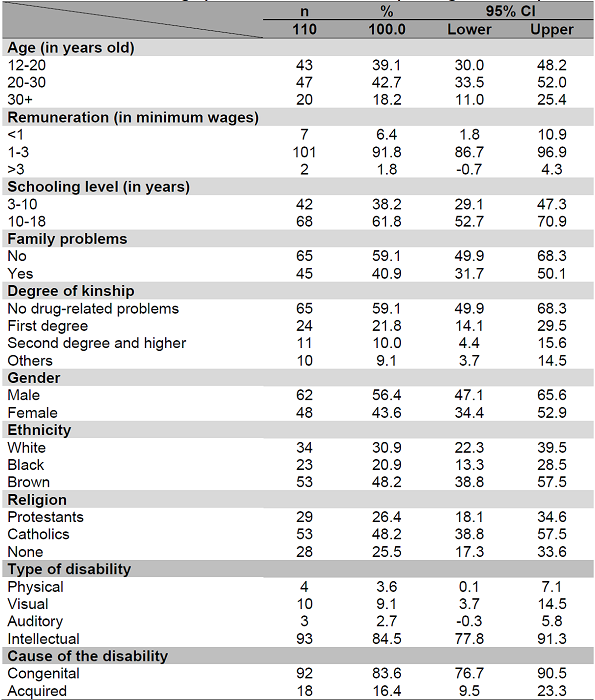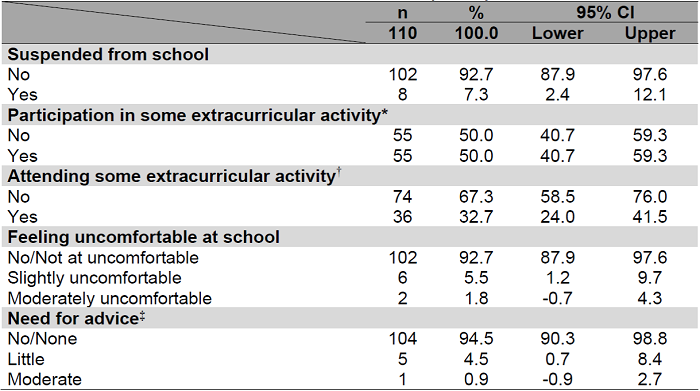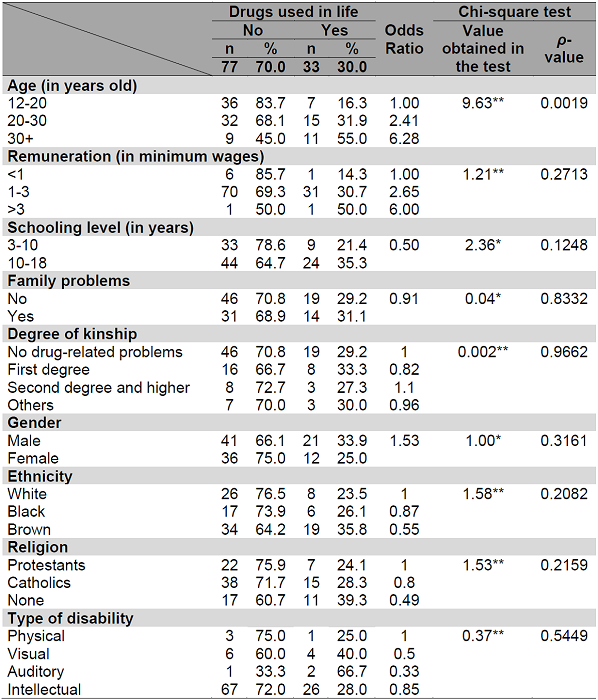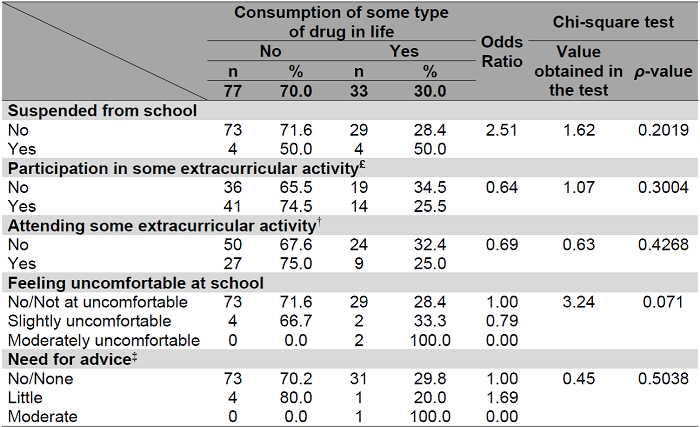Mi SciELO
Servicios Personalizados
Revista
Articulo
Indicadores
-
 Citado por SciELO
Citado por SciELO -
 Accesos
Accesos
Links relacionados
-
 Citado por Google
Citado por Google -
 Similares en
SciELO
Similares en
SciELO -
 Similares en Google
Similares en Google
Compartir
Enfermería Global
versión On-line ISSN 1695-6141
Enferm. glob. vol.23 no.73 Murcia ene. 2024 Epub 23-Feb-2024
https://dx.doi.org/10.6018/eglobal.568471
Originals
School situation and psychoactive substance use among students with disabilities
1Vitória Academic Center. Federal University of Pernambuco. Pernambuco. Brazil
2Nursing Department. Federal University of Pernambuco. Brazil
3Municipal Health Department, Vitória de Santo Antão. Pernambuco. Brazil
Objective:
To analyze the association between school situation and use of psychoactive substances by students with disabilities.
Methods:
A cross-sectional study carried out in public schools. The study population was students with disabilities. The Teen Addiction Severity Index questionnaire was used. The data were analyzed using the Chi-square test, the linear trend Chi-square test (Mantel-Haenszel extension) and the ANOVA test. The study was approved by Research Ethics Committee.
Results:
The participants were 110 students, most of them belonging to the age group between 20 and 30 years old, male, brown-skinned, Catholics, and with intellectual disabilities. 70% of the participants reported never having used psychoactive substances; in turn, 30% asserted having used these substances at least once in their lifetime. Among the substances consumed, 19.4% reported sedatives, 4.6% alcohol, 0.9% opioids, and 0.9% tobacco. There was an association between age and use of psychoactive substances. There was no significant association between school situation and use of these substances.
Conclusions:
The findings highlighted that there is greater consumption of licit psychoactive substances among students with disabilities, which is associated with age. These results are important for nurses to develop their activities to prevent psychoactive substance abuse.
Keywords: Psychotropic Drugs; Substance-Related Disorders; People with Disabilities; Students
INTRODUCTION
Drugs are any substance that is not produced by the body and which can act on one or more of its systems, triggering changes in body functioning(1).
Regarding drug use in children and adolescents, approximately 50% to 80% of the schoolchildren use legal or illegal chemical and pharmacological substances with recreational purposes(2).
A survey identified that the most used drugs by the students were alcoholic beverages and tobacco, with 42.4% y 9.6% per year, respectively(3). Another study determined that, within the group of adolescents that used some type of drug, there was a high tendency to maintain this attitude(4).
Consumption of psychoactive substances is associated with low grades, to the desire to dropout from school, to not doing the homework and to difficulty concentrating(5).
People with disabilities can also become susceptible to drug use due to contact with different social groups and to curiosity to try new situations(6).
Disabled individuals aged from 18 to 24 years old use heroin and cocaine more frequently that those with no disabilities(7). A study conducted with visually impaired people showed that most of the individuals that drink alcoholic beverages are men aged from 11 to 30 years old and Incomplete High School. This same study verified that some of the reasons leading these people to drink alcohol are issues related to leisure and entertainment(8).
A study showed that drug use by people with intellectual disabilities can be related to anxiety, depression, aggressive behavior, antisocial personality disorder and hyperactivity(9).
Another study identified scarcity of studies on drug use by people with disabilities, which represents a gap on the topic(10). In addition, in the city where the study was developed, the census indicated that there are 2,061 people with intellectual disabilities, followed by 552 that are unable to move by themselves, 273 blind individuals and 203 deaf subjects(11).
Consequently, it is important to understand the relationship between psychoactive substance use by students with disabilities and their school situation that nurses can make explicit in their interventions according to the principles from the Health at School Program. Hence our motivation to carry out this study.
Our hypothesis is that students with disabilities present high levels of psychoactive substance use, which is associated with their school situation. In this study, school situation is understood as participation in school-related activities, such as attendance, participation in extracurricular activities, uncomfortable situations at school or suspensions.
Therefore, the study objective was to analyze the association between school situation and psychoactive substance use among students with disabilities.
METHOD
This is a cross-sectional study with a quantitative approach. It was conducted in five municipal public schools. These institutions were selected because they offer inclusive education for people with disabilities.
The study population was comprised by students with disabilities enrolled in the schools providing inclusive education in the municipality. The inclusion criteria were the following: presenting some physical, auditory, visual or intellectual disability as per the student's file available in the school; both genders, and being aged at least 12 years old. We excluded students that presented multiple disabilities and those with difficulties to understand the questionnaire prompts.
According to the data provided by the municipal Education Department, 306 students with disabilities belonging to the age group from 12 years old onwards were enrolled in municipal schools during the data collection period. The formula for finite population was used for sample calculation, resorting to the following parameters: 10% error; 95% confidence level; population size of 306 students; and 50% prevalence. Consequently, we estimated a sample comprised by 74 participants. The sampling process for the study participants was for convenience.
The data were collected from the Portuguese version of the Teen Addiction Severity Index(T-ASI)(12), which assesses severity of psychoactive substance use by adolescents and other problems affecting their life. The questionnaire has 153 questions divided into seven domains: Psychoactive substance use; School situation: Employer; Family relationships; Peer relationships; Legal situation; and Psychiatric situation. Psychoactive substance use and School situation were investigated. These domains were chosen because they are related to the study purpose. The other domains were not researched for not being related to the objective proposed in this study. The questionnaire was validated for the Brazilian reality with a Cronbach's alpha of 0.89 in the Substance use domain(12).
The research team visited schools that provided inclusive education. The team presented the research to the school coordinators and then to the students. In this way, the researchers obtained due informed consent from the students' parents. The students answered the questionnaire on their own to ensure secrecy and privacy.
The study variables were as follows: sociodemographic (age, family income, schooling level, family problems, ethnicity, religion, type of disability, cause of the disability); school situation (suspension from school, participation in some extracurricular activity, having attended some extracurricular activity, feeling uncomfortable at school, need for advice); and consumption of psychoactive substances (drug use in life, type of substance).
The SPSS software program was used for data analysis. As a first step, a descriptive analysis of the different variables collected was performed. The variables were expressed as absolute and relative frequencies. The Kolmogorov-Smirnov test was used to verify data normality. The following tests were used to analyze the relationship between school situation and psychoactive substance use: Chi-square; linear trend Chi-square (Mantel-Haenszel extension); and ANOVA (Kruskal-Wallis test). 5% statistical significance was adopted.
The study was approved by the Research Ethics Committee (CAAE 57691516.5.0000.5208). The participants were asked for their consent to take part in the research.
RESULTS
A total of 110 students took part in the study. Table 1 indicates the sociodemographic characteristics corresponding to the sample. None of the study participants had even been in a controlled environment (prison, psychiatric hospital, rehabilitation clinic) in the year prior to the research.
Table 1: Sociodemographic characteristics corresponding to the sample.

Source: The authors
Note:95% CI - 95% Confidence Interval
Table 2 shows the information about the participants' school situation.
Table 2: School situation of the participants.

Source: The authors
Note:95% CI - 95% Confidence Interval
*Participation in some extracurricular activity: It refers to active participation in activities such as playing soccer.
†Yes: It refers to more passive participation, such as attending a soccer match.
‡Advice: It refers to the guidelines for problems related to the school situation.
Regarding psychoactive substance use, 70% of the students reported never having used them in life, whereas 30% stated consumed and/or having consumed them at least once. Among the students that use/used psychoactive substances, 19.4% reported sedatives, 4.6% alcohol, 0.9% opioids and 0.9% tobacco.
Table 3 shows the relationship between the sociodemographic variables and use of psychoactive substances.
Table 3: Association between drug use and sociodemographic characteristics.

Source: The authors
Note: *Chi-square test (Mantel-Haenszel extension),
**Linear trend Chi-square test (Mantel-Haenszel extension)
Tables 4 and 5 show the relationship between drug use and the variables related to schooling.
Table 4: Consumption of psychoactive substances and school situation.

Source: The authors
Note: *Mann-Whitney/Wilcoxon test for two samples (Kruskal-Wallis test for two groups).
Table 5: Association between consumption of psychoactive substances and school situation.

Source: The authors
Note: *Chi-square test (Mantel-Haenszel),
**Linear trend Chi-square test (Mantel-Haenszel extension)
£Participation in some extracurricular activity: It refers to active participation in activities such as playing soccer.
†Yes: It refers to more passive participation, such as attending a soccer match.
‡Advice: It refers to the guidelines for problems related to the school situation.
DISCUSSION
Regarding the most consumed substances, a study on psychoactive substance use among High School students with no disabilities showed that the four most consumed substances at least once in life were alcohol (79.6%), cigarettes (24.6%), solvents (10.3%) and anxiolytics (10.1%)(13), findings that are similar to those in this research.
Another survey is similar to this study, identifying that 33.9% of the people with disabilities used sedatives with no medical prescriptions, whereas this percentage was 15% among those with no disabilities(7).
In a comparative study between individuals with and without disabilities, we noticed that the people with disabilities presented more chances of being smokers that those with no disabilities(14). This differs from the study, where only 0.9% of the participants use tobacco. This divergence can be the difference between the participants' age groups in the studies since, in the aforementioned one, the age group was from 45 to 54 years old whereas it was from 20 to 30 years old in this paper, in addition to the cultural aspects between both research loci.
A study on the consumption of tobacco, alcohol and other drugs among adolescents with and without mild to moderate intellectual disabilities concluded that young people with such impairments present fewer chances of using legal and illegal substances than those with not disabilities(15), which corroborates the results presented. There was absolutely no report on the use of illicit psychoactive substances in the study, which differs from previous surveys that evidenced consumption of these substances by adolescents with intellectual disabilities and schoolers with no disabilities. There was greater prevalence of cannabis among the most consumed illicit drugs(16,17,18).
Regarding the school situation, we did not find any statistically significant association between psychoactive substance use and this variable in our study; however, we noticed that, on average, the students that use substances did not attend school and missed classes more days than those who do not make use of them.
In this sense, a study that compared groups of students who were ''hearing impaired (HI) with multiple disabilities'', pupils that were ''only hearing impaired'', schoolers with ''some disability other than hearing impairment', and students ''with no disabilities'' showed that 72% of the “Hearing impaired with multiple disabilities” group members reported not attending school, whereas 46% of the students with no disabilities presented this school situation(19).
A study compared alcohol consumption between adolescents with and without hearing impairments. Those without hearing impairments drank more alcohol and had worse school grades that their hearing impaired counterparts(20). Also in relation to the school situation, another study on the prevalence of risk behaviors due to consumption of cigarettes, alcohol and marijuana among students with no disabilities showed that the prevalence of such behaviors was higher in those who missed classes(21), which is similar to the results herein pointed out, where the students that had school problems were psychoactive substance users.
The study limitation is related to the convenience sampling technique, reason why the results cannot be generalized to other realities.
CONCLUSIONS
In this study it was possible to verify the association between the “school situation” and “psychoactive substance us” variables among students with disabilities. The study highlighted that the consumption of sedatives was higher among the students with disabilities, which is related to age. Although there is absolutely no association with the school situation, it was observed that, on average, the students who use psychoactive substances did not attend school and missed classes more days.
These findings contribute to understanding the consumption patterns of psychoactive substances among students with disabilities. These results might help nurses to develop more specific strategies for these groups in their activities.
REFERENCIAS
1. Word Health Organization (WHO). Classificação de transtornos mentais e de comportamento da CID-10. Porto Alegre: Artes Médicas Sul, 1993. [ Links ]
2. Freitas NO, Souza JC, Araújo EC. O consumo de bebidas alcoólicas e de outras substâncias psicoativas entre os jovens. Rev. Enferm. UFPE on line. 2015:9(8). http://periodicos.ufpe.br/revistas/revistaenfermagem/article/view/10658 [ Links ]
3. Centro Brasileiro de Informação sobre Drogas Psicotrópicas (CEBRID). VI Levantamento Nacional sobre o consumo de drogas psicotrópicas entre estudantes do ensino fundamental e médio das redes públicas e privada de ensino nas 27 capitais brasileiras. Brasília: SENAD; 2010. [ Links ]
4. Ferreira BVO, Frazão IS, Chaves LCMR, Souza JS, Brito VCNG, França VV, et al. Atitudes de adolescentes escolares sobre o consumo de álcool e outras drogas: estudo transversal. Rev baiana enferm. 2022;36:e44908. [ Links ]
5. Cardoso LRD, Malbergier A. Problemas escolares e o consumo de álcool e outras drogas entre adolescentes. Psicol Esc. Educ. 2014;18(1). https://doi.org/10.1590/S1413-85572014000100003 [ Links ]
6. Pagliuca LMF, Cezario KG, Mariano M R. A percepção de cegos e cegas diante das drogas. Acta paul enferm. 2009;22(4):404-11. https://doi.org/10.1590/S0103-21002009000400009 [ Links ]
7. Gilson SF, Chilcoat HD, Stapleton JM. Illicit drug use by persons with disabilities: insights from the National Household Survey on Drug Abuse. Am. J. public health. 1996;86(11):1613-1615 10.2105/ajph.86.11.1613 [ Links ]
8. Silva GRF, Macêdo KNF. Alcohol Consumption among People with Visual Deficiencies. Enferm. Glob. 2005;4:1-7. [ Links ]
9. Didden R, Embregts P, Van MDT, Laarhoven N. Substance abuse, coping strategies, adaptive skills and behavioral and emotional problems in clients with mild to borderline intellectual disability admitted to a treatment facility: a pilot study. Res. dev. disabil. 2009;30(5):927-932.https://doi.org/10.1016/j.ridd.2009.01.002 [ Links ]
10. Guimarães FJ, Mariano MR, Pagliuca, LMF. Psychoactive Substance Use and Disabled People: An Integrative Review. Health. 2016;8:1411-1422. http://dx.doi.org/10.4236/health.2016.814142 [ Links ]
11. Instituto Brasileiro de Geografia e Estatística (IBGE). Censo 2010. Disponível em: https://censo2010.ibge.gov.br/ [ Links ]
12. Sartes LMA. Versão brasileira do T-ASI (Teen Addiction Severity Index): análise da consciência interna e validação da área de uso de substâncias. Tese de mestrado. Universidade Federal de São Paulo; 2005. http://repositorio.unifesp.br/handle/11600/20638. [ Links ]
13. Lopes AP, Rezende MM. Consumo de substâncias psicoativas em estudantes do ensino médio. psicol. teor. prát. 2014;16(2). http://pepsic.bvsalud.org/scielo.php?script=sci_arttext&pid=S1516-36872014000200003&lng=pt&tlng=pt. [ Links ]
14. Brawarsky P, Brooks D, Wilber N, Gertz R, Klein W. Tobacco use among adults with disabilities in Massachusetts. Tob. Control. 2002;11(2):29-33 [ Links ]
15. Robertson J, Emerson E, Baines S, Hatton C. Self-reported smoking, alcohol and drug use among adolescents and young adults with and without mild to moderate intellectual disability. J. intellect. dev. disabil. 2018;45(1):1-11 https://doi.org/10.3109/13668250.2018.1440773 [ Links ]
16. Malta DC, Mascarenhas MDM, Porto DL, Duarte EA, Sardinha LM, Barreto SM, et al. Prevalência do consumo de álcool e drogas entre adolescentes: análise dos dados da Pesquisa Nacional de Saúde Escolar. Rev Bras Epidemiol. 2011;14:136-146. https://doi.org/10.1590/S1415-790X2011000500014 [ Links ]
17. Neto C, Fraga S, Ramos E. Consumo de substâncias ilícitas por adolescentes portugueses. Rev Saúde Pública. 2012;46:808-815. https://doi.org/10.1590/S0034-89102012000500007 [ Links ]
18. Swerts, C., Vandevelde S, Vandernagel JEL, Vanderplasschen W, Claes C, Maeyer J. Substance use among individuals with intellectual disabilities living independently in Flanders. Res Dev Disabil. 2017;63:107-117. http://hdl.handle.net/1854/LU-7169185 [ Links ]
19. Brunnberg E, Boström ML, Berglund M. Self-rated mental health, school adjustment, and substance use in hard-of-hearing adolescents. Journal of Deaf Studies and Deaf Education. 2007;13(3):324-335. https://doi.org/10.1093/deafed/enm062 [ Links ]
20. Pinquart M, Pfeiffer JP. Alcohol use among students with and without hearing loss. J deaf stud deaf educ. 2015;20(1):82-90. http://pubmed.ncbi.nlm.nih.gov/25318927/ [ Links ]
21. Bovet P, Viswanathan B, Faeh D, Warren W. Comparison of Smoking, Drinking, and Marijuana Use Between Students Present or Absent on the Day of a School Based Survey. J sch health. 2006;76(4):133-137. https://doi.org/10.1111/j.1746-1561.2006.00081.x [ Links ]
Received: May 02, 2023; Accepted: September 29, 2023











 texto en
texto en 


